

Richard Chichester (1423-1496), lord of the manor of Raleigh in the parish of Pilton, near Barnstaple, North Devon, was twice Sheriff of Devon, in 1469 and 1475.


Richard Chichester (1423-1496), lord of the manor of Raleigh in the parish of Pilton, near Barnstaple, North Devon, was twice Sheriff of Devon, in 1469 and 1475.
He was the son and heir of Sir John Chichester (1385-1437) [1] of Raleigh (who fought in the Battle of Agincourt (1415) in the retinue of the Sieur de Harrington) by his wife Alice Wotton, daughter and co-heiress of John Wotton, lord of the manor of Widworthy, Devon. Sir John was the son and heir of John Chichester (fl.1365) (lord of the manors of Treverbin in Cornwall and of Beggerskewish and Donwer in Somerset. [2] ) by his wife [3] Thomasine de Raleigh (d.1402), daughter and heiress of Sir John De Raleigh of Raleigh.
He was a minor aged 14 on his father's death and entered wardship to a person unknown. He served as Sheriff of Devon in 1469 and 1475.
He married twice:
He died on 25 December 1496 [2] and his Inquisition post mortem was taken in 1498. His ledger stone survives set into the floor of the chancel aisle of Pilton Church. His heir was his grandson John Chichester (1472-1537/8), eldest son and heir apparent of Nicholas Chichester.

Arlington was a manor, and is a village and civil parish in the North Devon district of Devon in England. The parish includes the villages of Arlington and Arlington Beccott. The population of the parish is 98.
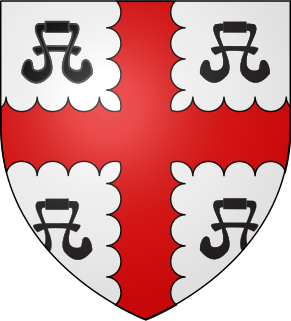
John Bourchier, 1st Earl of Bath was created Earl of Bath in 1536. He was feudal baron of Bampton in Devon.

Sir John Chichester (1519/20-1569) of Raleigh in the parish of Pilton, near Barnstaple in North Devon, was a leading member of the Devonshire gentry, a naval captain, and ardent Protestant who served as Sheriff of Devon in 1550-1551, and as Knight of the Shire for Devon in 1547, April 1554, and 1563, and as Member of Parliament for Barnstaple in 1559, over which borough his lordship of the manor of Raleigh had considerable influence.

The historic manor of Raleigh, near Barnstaple and in the parish of Pilton, North Devon, was the first recorded home in the 14th century of the influential Chichester family of Devon. It was recorded in the Doomsday Book of 1086 together with three other manors which lay within the later created parish of Pilton. Pilton as a borough had existed long before the Norman Conquest and was one of the most important defensive towns in Devon under the Anglo-Saxons. The manor lies above the River Yeo on the southern slope of the hill on top of which exists the ruins of the Anglo-Saxon hillfort of Roborough. The historic manor of Raleigh is now the site of the North Devon District Hospital.

Hall is a large estate within the parish and former manor of Bishop's Tawton, Devon. It was for several centuries the seat of a younger branch of the prominent and ancient North Devon family of Chichester of Raleigh, near Barnstaple. The mansion house is situated about 2 miles south-east of the village of Bishop's Tawton and 4 miles south-east of Barnstaple, and sits on a south facing slope of the valley of the River Taw, overlooking the river towards the village of Atherington. The house and about 2,500 acres of surrounding land continues today to be owned and occupied by descendants, via a female line, of the Chichester family. The present Grade II* listed neo-Jacobean house was built by Robert Chichester between 1844 and 1847 and replaced an earlier building. Near the house to the south at the crossroads of Herner the Chichester family erected in the 1880s a private chapel of ease which contains mediaeval woodwork saved from the demolished Old Guildhall in Barnstaple.

The Manor of Molland was a medieval manor in North Devon, England. It was largely co-terminous with the existing parish of Molland, in which is situated the village of Molland. More accurately it consisted from the earliest times of two separate manors, held from separate overlords, later known as Molland-Bottreaux and Molland-Champson.
The Manor of Shirwell was a manor in North Devon, England, centred on the village of Shirwell and largely co-terminous with the parish of Shirwell. It was for many centuries successively the seat of two of the leading families of North Devon, the Beaumonts and their heirs the Chichesters of Raleigh, Pilton, both of which families were seated at the estate of Youlston within the manor of Shirwell. The manor house which survives today known as Youlston Park is one of the most architecturally important historic houses in North Devon and exists largely in its Georgian form, but retains many impressive late 17th-century interiors.
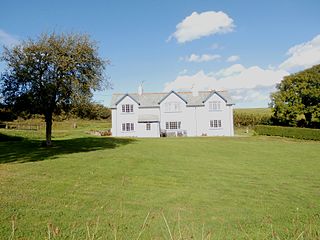
Incledon in the parish of Braunton, North Devon, England, is an ancient historic estate which gave its name to the locally prominent de Incledon family, first recorded in 1160. It is situated one mile north-west of St Brannock's Church in Braunton. Its relationship to Incledon Hill in the parish of Georgeham, where is situated a modern farmhouse also called Incledon, 1 1/4 miles north-west of Incledon in Braunton, is unclear. In 1319 the Incledon family purchased the adjoining estate of Buckland, and the present Georgian Buckland House, 1/2 mile south-east of Incledon, is still occupied in 2014 by descendants of the Incledon-Webber family.

Buckland in the parish of Braunton, North Devon, England, is an ancient historic estate purchased in 1319 by Godfrey II de Incledene of Incledon, the adjoining estate about 1/2 mile to the north-west, whose family, is first recorded in 1160. It is situated half a mile north-west of St Brannock's Church in Braunton. Buckland House, a grade II* listed mansion remodelled in the 18th century, is still occupied in 2014 by descendants of the Incledon-Webber family, formerly prominent in the political and commercial life of nearby Barnstaple and North Devon. The owner of the estate in 1937, William Beare Incledon-Webber was also lord of the manor of nearby Croyde and Putsborough.

Mohuns Ottery or Mohun's Ottery, is a house and historic manor in the parish of Luppitt, 1 mile south-east of the village of Luppitt and 4 miles north-east of Honiton in east Devon, England. From the 14th to the 16th centuries it was a seat of the Carew family. Several manorial court rolls survive at the Somerset Heritage Centre, Taunton, Somerset.

The Manor of Poltimore is a former manor in Devon, England. The manor house known as Poltimore House survives in its 18th-century remodelled form, but has been dilapidated for several decades. A charity named the "Poltimore House Trust" has been established for the purpose of its restoration. The manor was situated within the historic Wonford Hundred and was largely coterminous with the parish of Poltimore and contained the village of Poltimore, 4 miles (6.4 km) north-east of the historic centre of the City of Exeter. It should not be confused with the eponymous Devon estate of Poltimore in the parish of Farway, 16 miles (26 km) east of Exeter. Poltimore was the principal seat of the Bampfylde family from c. 1300 to 1920.

The Manor of Copleston was a manor in the parish of the parish of Colebrooke in Mid Devon, England, now centred on the village of Copplestone.
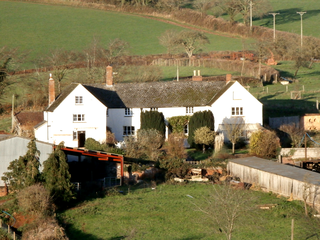
Ruxford is an historic estate in the parish of Sandford, near Crediton in Devon.

Sir John Chichester lord of the manor of Raleigh in the parish of Pilton, near Barnstaple, North Devon, was Sheriff of Devon in 1576/7 and/or in 1585 and died of gaol fever contracted whilst acting as a magistrate at the Lent Black Assizes of Exeter in 1586.
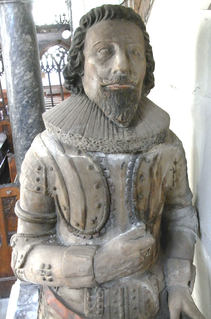
Sir Robert Chichester (1578–1627,, lord of the manor of Raleigh in the parish of Pilton in Devon, was Custos Rotulorum and Deputy Lieutenant of Devon.

Sir John Kirkham (1472–1529) of Blagdon in the parish of Paignton, Devon, was Sheriff of Devon in 1523/4. He was one of the Worthies of Devon of the Devonshire biographer Prince (d.1723), who called him a "very free and liberal, ... prudent and discreet" benefactor of the town of Honiton in Devon.
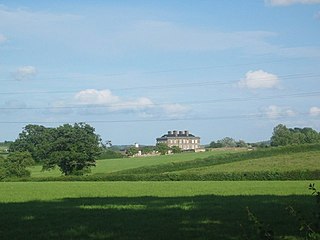
Kingston is an historic estate in the parish of Staverton in Devon, England. The surviving large mansion house, known as Kingston House is a grade II* listed building, rebuilt in 1743 by John Rowe, after a fire had destroyed the previous structure. The Kingston Aisle or Kingston Chapel survives in the parish church of Staverton, built by and for the use of, the successive owners of the Kingston estate.

Indio in the parish of Bovey Tracey in Devon, is an historic estate. The present large mansion house, known as Indio House is a grade II listed building rebuilt in 1850, situated about 1/2 mile south of Bovey Tracey Church, on the opposite side of the River Bovey. According to the Devon historian Pole (d.1635) it was originally a priory, however research from 1840 onwards has suggested it was more likely merely a grange farm, a possession of St John’s Hospital, Bridgwater, Somerset, from 1216.

Walter Reynell of Malston in the parish of Sherford, Devon, was a Member of Parliament for Devon in 1454/5.
The manor of Modbury was a manor covering the ecclesiastical parish of Modbury in Devon. The manor house, last occupied by the Champernowne family and known as "Court House", was situated on the north side of the parish church of St George, on or near the site of Modbury Priory, founded in the 12th century by the Vautort lords of the manor. It was destroyed during the Civil War (1642–1651) and the remnants were sold for building materials in 1705.
| Political offices | ||
|---|---|---|
| Preceded by Philip Beaumont | High Sheriff of Devon 1468–1469 | Succeeded by Nicholas Carew |
| Preceded by Richard Pomeroy | High Sheriff of Devon 1474–1475 | Succeeded by Otes Gilbert |